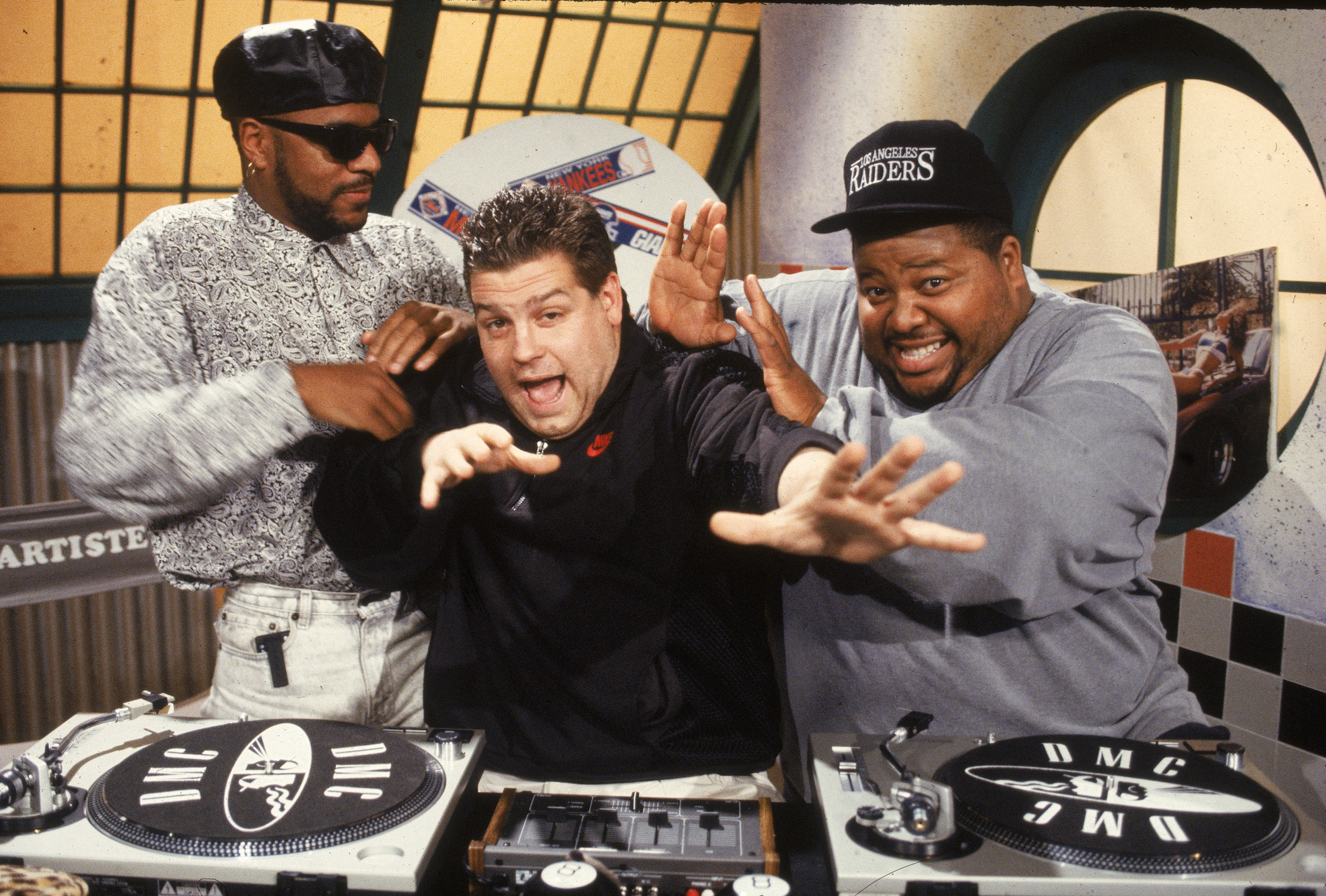Donnie Wahlberg is led out of a Kentucky courtroom in handcuffs, burly police deputies clearing a path through the crowd of anxious adolescents. The New Kids, it seems, have fallen on hard times: Wahlberg’s hair touches his shoulders, a shaggy beard curls down around his mouth. Like an old dog responding to some faraway sound Wahlberg turns at last toward the camera. Staring solemnly from Wahlberg’s chest, Malcolm X raises his fist and salutes the cameraman from MTV News. Seated on the couch in the Yo! MTV Raps green room, Posdnuos of De La Soul can’t believe what he is seeing. Eyes wide behind wire-rimmed glasses, he points a long finger at the television set. “Man, did you see that?” he asks, pointing. “Did you see that? Just another white boy trying to be black.”
The studio monitor goes blank, then blinks on to Kurt Loder, shuffling papers at the MTV news desk. Loder grimaces at the camera. “Someone get me a shot of heroin,” he mutters. No response. “Are we finished here or what?”
Over the course of the three years since Ted Demme, then a lowly production assistant, approached producer Peter Dougherty with an idea for a program of rap videos, Yo! MTV Raps has become the most important forces in hip hop. Yo! MTV Raps is MTV’s highest-rated show. Its audience—white, male, suburban, and between the ages of 16 and 24—is the largest segment of the rap-buying public. For this audience, Yo! Is also an important provider of cultural clues, explicating the style and sound of urban black America. This is why Posdnuos’s comment was so potentially provocative, the rare sound of a man biting down hard on the hand that feeds him.
Hank Shocklee, the razor-thin musical visionary and hip hop genius, fiddles with a paper clip on an abandoned desk in the offices of his S.O.U.L. label, home to the upcoming musical debut of Ed Lover and Dr. Dre, Yo!’s knockabout weekday hosts. “Your average R&B song uses eight or ten verses,” Shocklee explains, “seventy-five or eighty words. Rap uses four for five times that number, giving you more insight into the artist, creating full characters like pop has never seen. Whites have always liked black music, that’s nothing new. With rap, for the first time, the imagery of black artists is brought up to the level of black music. Video and rap go together quite naturally. Yo! Is like a world. Ed, Dre, and Fab Five are characters just like the rappers. They’ve done a fantastic job.”
Others are not so sure. “I think the music is dying,” says Def Jam founder Rick Rubin on the phone from Los Angeles. “Rap has moved into the suburbs. Ice Cube, N.W.A, Public Enemy—I’d say 90 percent of their audience is white and suburban now. People who don’t understand the music are controlling it now, ramming endless numbers of horrible groups down our throats to make a buck. Everyone wants to be the new Hammer, the new Vanilla Ice. I think MTV and the big music companies are responsible.” Bill Stepheney, the conceptual mind behind Public Enemy and Hank Shocklee’s onetime partner, has a slightly different take on the matter. “Black radio never programmed the music. No one adopted the music and the culture until MTV came along, and it became the first national validated audience.”
Three days later, on the promenade in Brooklyn, Fab Five Freddy is taping a Saturday show with guest EPMD. True to its album covers, the group arrives in a brand-new Mercedes with sunroof, cellular telephone, and fly girls in tow, attracting the attention of an admiring crowd. “Check it out, man,” one says. “That nigger got a phone in his car!” Wearing heavy gold, matching white pants, black boots, and thick black belts unbuckled, Eric and Parish run the video monitor after every take to check out how they did.
Fab Five Freddy lurks on the sidelines, chain smoking between takes. Finally, it’s his turn to shine. “Yo, I’m Fab Five Freddy and I’m a fab motherfucker.” Cut. “Yo, Fab Five Freddy here, Yo! MTV Raps’ motherfucker.” Cut. Freddy can’t seem to stop. Associate producer Moses Edinborough gets annoyed, Fab Five gets it straight. Time for the closing shot. The camera zooms in, and Parish calls a halt. “Wait a minute,” he says, “you got to get the Rolex in.” Eric and Parish hold matching Rolexes up to the camera, while Freddy plays with his scarf. Cameras roll. Fab Five turns to his guests, a nice easy grin. “Lambskins, man,” he says. “I can’t fuck with those things on.” Cut. Taking in the scene on their lunch break are two aging white businessmen, neither of whom seem to approve. “I can’t believe they just put this shit on TV,” says one.
https://player.vimeo.com/video/35643246
Judged strictly on its merits, Yo! MTV Raps is a fine show. Video programming, the subject and result of neverending argument among Demme, Dre, Ed, Fab, and Edinborough, is current and progressive, responsible for breaking any number of new acts. Where rap videos once looked like late-night local programming, L.L. Cool J, Public Enemy, and De La Soul, in particular, have found creative ways to use the form, producing videos that augment rather than just illustrate the music. Rap is young America’s music of choice, and rappers, by the hundreds, are getting paid.
Yo’s achievement is all the more remarkable when judged against the rest of MTV’s programming, an increasingly uninspired mix of unlikable hosts and third-rate game shows, sunk deep in a noxious swamp of videos that slither across the screen like escapes from the Coors Light commercial reject bin. It is an odd mixture of the shoddy and the calculated, ugly to look at. Arty snippets of creative people talking about their work, some superb animation, and those cool MTV logos only point up the whistling vacuum at the heart of a once-interesting experiment. In this subterranean world, Yo! MTV Raps mines a vein of pure gold.
It approaches the ungrateful, then, to explore in the case against Yo!, a case that rests largely on bits and scraps of circumstantial evidence. The year before Yo! Came on air saw the release of artistically innovative first albums by acts including De La Soul, Big Daddy Kane, and N.W.A. Since MTV took to airing rap, a new trio has emerged: M.C. Hammer, Vanilla Ice, and Gerardo. While Yo! Is hardly responsible for these acts, not even their publicists would claim that music is what’s selling records.
In some larger way, too, bubble-gum rap has ghettoized the rest of hip hop, forcing acts to define themselves against the mainstream. Some, like Dream Warriors and Main Source, turn artsy and serious. Others, from Brand Nubian to the Geto Boys, play out street fantasies and champion violence and hate. The emphasis placed by rappers of all persuasions on image has increased; the music has steadily declined. Perhaps this process is a natural result of rap’s journey into the mainstream; as the vehicle for that journey, MTV deserves its fair share of the blame.
But none of these arguments get to the heart of Yo!’s popularity, which is, in many ways, the most provocative aspect of its existence, the key to which Posdnuos pointed to before going on the air. For many, white and black alike, what is exciting about rap today is not simply the music but its blackness, the supercharged images that Hank Shocklee sees as essential to the form. The blackness of rap has proved to be a natural fit with the traditional thrust of rock’n’roll rebellion, the seizure of power by the disempowered outlaw. The fact that these outlaws are black compounds the thrill of opposition with the breach of racial barriers.
It is impossible not to analyze Yo! MTV Raps as race theater, an element that has always existed in rap but is now, more than ever, central to its success. To Chuck D, Yo! is “the black CNN,” a means for the voices and images of young black America to be seen and heard. MTV senior vice president of programming Doug Herzog agrees. “If you are 17 years old and living in Des Moines, you’re not going to pick up the New York Times. If you watch Yo! MTV Raps, you’re going to learn a little more about race in America.
These lessons, says Fab Five Freddy, are all to the good: “Think about those kids, when they get in there and run society. They won’t be as narrow-minded as their parents were. See, black people do it all the time. We know how whites live. We don’t have to think about it. Motion pictures, television, they’re all full of how white people live, act, how they kiss. Now things are swinging around a little bit.”
This interest, says Hank Shocklee, is entirely natural. “What is white culture?” Shocklee asks. “You have Jewish kids who don’t go to synagogue, kids who are Italian, Irish, Polish, German—their cultures are so far away from them, generations back. They’ve never even seen the places their great-grandparents came from. Kids are going to pick on something close to their environment. And when you find out your environment doesn’t have anything universal that defines your community, you’re going to look somewhere else. So you might get into black culture, because you went to a high school that’s 40 percent white and 60 percent black, and you grew up listening to black music. So are you lost?”
Walking down lower Broadway on a sunny Friday afternoon, picking out the cool white boys in Raiders caps and the occasional leather Africa medallion, one starts to wonder. Young black males have become fashion plates for millions, black and white, beepers and guns the latest cool accessories. Engagement with black culture is a step toward understanding, an expansion of knowledge. The transformation of the street into style is something else, the consumption as entertainment of what should, deep down, make us sick at heart.
The real and inescapable lesson of Yo! MTV Raps is that hip hop is, as it has been for years, the music of middle-class Americans, black and white. The distance from Ice Cube to Young Black Teenagers is not half as far as it seems. Ghettos, guns, and violence against women become abstract symbols of rebellion, stripped of all meaning. It is past time to dismiss the idea that one is hearing some kind of straight reporting from the urban war zone. What you hear is dance music, and what you see is style. That ghettos do exist is no excuse for their being consumed as entertainment.
By using race to sell records, rap has taken an unwelcome turn away from the possibilities it once held out for defining a youth culture. The mere fact of rap’s blackness contributes little to no change: A generation has now grown up on rap, and relations between young blacks and whites are as tense as ever. Race is an important factor in rap as it is in society at large: The only difference is that in rap songs, young urban blacks come out on top. Behind the scenes, at places like Yo! And in dozens of record companies and recording studios across the country, young blacks and whites work side by side in creative and interesting ways. Perhaps this relationship will one day be reflected in the music; so far it has not.
The shame in all this is that images of young blacks and whites creating music together could lead, as it did in the late ‘70s and early ‘80s in England, to the definition of a new youth culture that questions racial divisions instead of exploiting them for image and profit. Such that was the high promise that Yo! MTV Raps held out when it first went on the air. It is a promise on which the music, and its audience, have so far failed to deliver.





